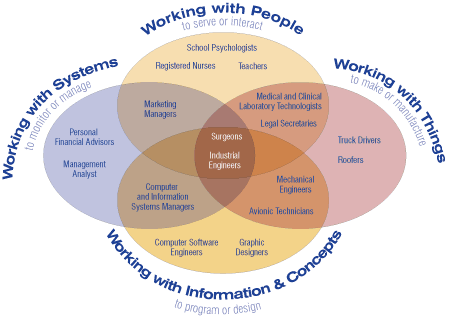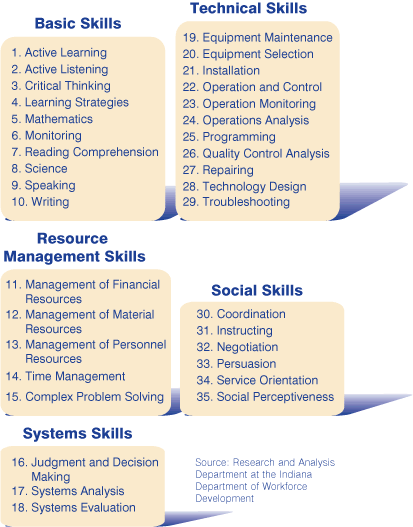The Butcher, the Baker and the Candlestick-Maker Revisited: Indiana's New Skills-Based Career Clusters
There was a time when people's decisions about what they wanted to do for a living revolved around a particular industry—nursing in hospitals, working in the steel mill, or teaching in schools. Their thinking was often reflected in the idea that they would spend most of their careers with a single employer.
Enter the 21st century, where tenure with an employer is measured in projects or years instead of decades; many individuals shed occupational “skins” several times during their working life, and flexibility is crucial. Today's emerging workforce must prepare for an ever-evolving, quick-paced job market that demands highly-skilled, adaptable and versatile workers. To facilitate the transition of dislocated and entry-level workers into careers based on key transferable skills, the Research and Analysis (R&A) arm of Indiana's Department of Workforce Development (DWD) has developed a new tool for examining the occupations expected to grow in Indiana's economy over the next decade (see Figure 1).
Figure 1: Selected Occupations in Indiana's New Career Cluster Model

Background
The R&A division's new career clusters are based on the skills necessary for emerging high wage and high demand (HWHD) occupations. This work is tied to Indiana's Strategic Skills Initiative which is designed to create new jobs and raise Hoosier income through innovation and investing in human capital. Developing the skills of Indiana's workforce is vital to the success of the Strategic Skills Initiative and to building Indiana's economy. The goal of this new career cluster model is three-fold:
- Emphasize skills that are transferable within the career clusters and across seemingly unrelated occupations and industries.
- Shape policy and behaviors around Indiana's HWHD occupations and skills through the promotion of skill development programs and curricula.
- Identify career pathways that lead to HWHD occupations and to prioritize and focus resources on programs and curricula that promote skills leading to those occupations.
Methodology
The first step was to review a list of more than 700 occupations coded by the Standard Occupational Classification system (SOC). Next, a filter was applied to include only occupations that were both high in wages and high in demand. To fit this criterion, the occupation needed to have an average wage above the state median income of $27,742 and have a positive projected growth rate over the next decade; 233 occupations qualified as HWHD throughout Indiana. Finally, the analysis incorporated skills data from the Occupational Information Network (O*NET), a comprehensive database of worker attributes and job characteristics. O*NET categorizes knowledge, skills and abilities as worker requirements that represent the developed or acquired attributes of an individual and contribute to occupational performance. (1)
All 717 SOC-coded occupations were included in Indiana's R&A Career Cluster initial analysis, and each occupation was coded with 35 O*NET occupational skills (see Table 1).
Table 1: O*NET Occupational Skills

There were three skill measurements for each occupation. They were given a rank of skill importance (from 1 to 35), and an importance and level index score based on survey data. The importance score from 1 to 5 (with 1 being not important and 5 being extremely important) was based on the following question: How important is the skill to the performance of your current job? If the skill was considered at least somewhat important (2), the employee was instructed to answer the following question as well: What level of the skill is needed to perform your current job? The level scale is from 1 to 7, with 1 being low and 7 being high.
Statistical Analysis
Clusters were determined through a factor analysis (principal components method) of O*NET skills plus DWD employment and wage data. This process determined which skills load highly together among the occupations. To determine which skills were especially relevant to particular career clusters, skills were chosen as statistically significant with coefficients of 0.5 or greater. Once the clusters were defined by the skills, all occupations were re-coded and categorized. The occupations have been placed into these skill clusters based on a match of best fit according to the O*NET coded skill importance and level scores, and by applying theory and knowledge of the Indiana education system and labor market.
Additional Details on Methodology Decisions
Three key decisions on scope and methodology were made.
- Complete factor analysis on all 717 occupations vs. just the HWHD occupations that inspired the work: The model using just the HWHD occupations proved to be stronger both statistically and theoretically.
- Use of the skill importance index vs. the skill rank: Clusters formed by rank explained approximately 65 percent of the model variance, whereas clusters formed by the importance index provided a much stronger model, explaining close to 80 percent of the model variance.
- Use of basic and non-basic skills from O*NET: The 10 basic skills were clouding the model. Each of these basic skills is important to virtually all of the HWHD occupations. Once these were taken out of the model, and only 25 “differentiating” skills were used, the model strength improved once again.
Remembering that the O*NET skills importance index is scaled from 1 to 5, a score of 2 means that skill is somewhat important and 3 indicates that skill is important. We designated the critical importance score of 2.75, which allowed for variance among the clusters, while maintaining a high importance index score to ensure confidence in the model and accuracy among the occupations that fit into each cluster. This analysis yielded four key skill clusters with associated occupations (see Table 2).
Table 2: Key Skill Clusters
This new occupational cluster matrix is designed to guide individuals, educators and workforce professionals to careers and occupations that provide a good “fit” or a faster, smoother transition between seemingly unrelated jobs with similar skills. It builds off the skills, knowledge and strengths these people already possess (or choose to develop). A critical step of this process is to perform a sound assessment of the individual's current skills using a tool such as WorkKeys. A second aim involves developing career paths that lead from entry level to better-paying jobs through a planned, logical and layered acquisition of the needed skills and training that equips the individual for the higher level position. These intended uses of the new clusters embody DWD's goals of growing employment and personal income for Indiana's workforce.
Additional details on methodology decisions can be found in the online version of this article at www.incontext.indiana.edu.
Notes
- O*NET collects data from a random sample of businesses expected to employ workers in the targeted occupations. From the sample of businesses, a random sample of workers in those occupations are selected to be surveyed using standardized questionnaires.
Allison Leeuw, Advanced Economic and Market Analysis Team of Research and Analysis
Indiana Department of Workforce Development

